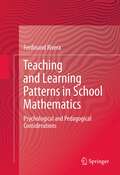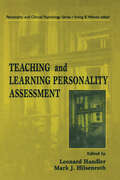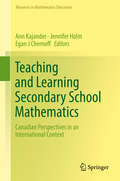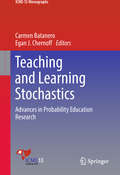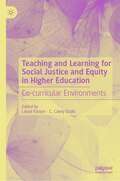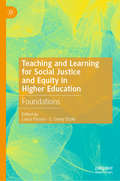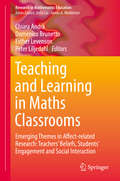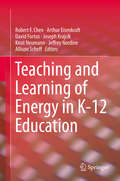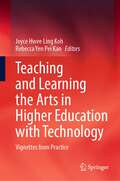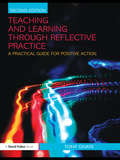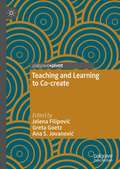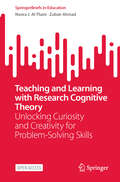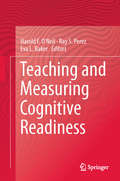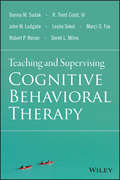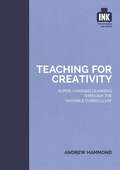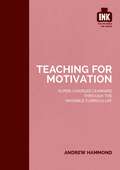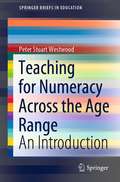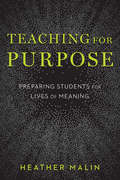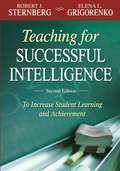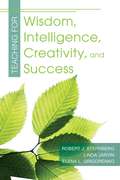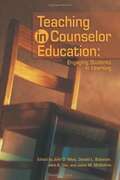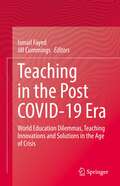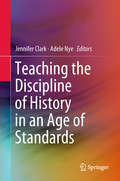- Table View
- List View
Teaching and Learning Patterns in School Mathematics
by Ferdinand RiveraThis book synthesizes research findings on patterns in the last twenty years or so in order to argue for a theory of graded representations in pattern generalization. While research results drawn from investigations conducted with different age-level groups have sufficiently demonstrated varying shifts in structural awareness and competence, which influence the eventual shape of an intended generalization, such shifts, however, are not necessarily permanent due to other pertinent factors such as the complexity of patterning tasks. The book proposes an alternative view of pattern generalization, that is, one that is not about shifts or transition phases but graded depending on individual experiences with target patterns. The theory of graded representations involving pattern generalization offers a much more robust understanding of differences in patterning competence since it is sensitive to varying levels of entry into generalization. Empirical evidence will be provided to demonstrate this alternative view, which is drawn from the author's longitudinal work with elementary and middle school children, including several investigations conducted with preservice elementary majors. Two chapters of the book will be devoted to extending pattern generalization activity to arithmetic and algebraic learning of concepts and processes. The concluding chapter addresses the pedagogical significance of pattern learning in the school mathematics curriculum.
Teaching and Learning Personality Assessment
by Leonard Handler Mark J. HilsenrothHow do we move from an understanding of the administration, scoring, and interpretation of responses on various personality assessment instruments to the ability to put our understanding into words and communicate it effectively to referral agents and to patients themselves? And how do we transmit that ability to students? Teaching and Learning Personality Assessment strives to fill a gap in the literature and in many training programs. The editors have assembled a group of renowned clinicians, noted not only for their own acumen in personality assessment but also for their teaching talent, who present in detail time-tested techniques for teaching assessment. Readers have the opportunity to "sit beside" these seasoned mentors and learn their special skills. Numerous examples illustrate the key concepts. For every instructor of personality assessment who has ever pondered ways to organize a course or to convey difficult material, and for every student who has worried about how to translate theory into practice, in the context of a course or on his or her own, this book will offer enlightenment and provide uniquely practical assistance. It will be important reading for psychologists and trainees at every level of experience. Its clear style, vivid anecdotes, frank discussion of disagreements in the field, and innovative ideas make it an excellent text for both introductory and advanced courses.
Teaching and Learning Secondary School Mathematics: Canadian Perspectives in an International Context (Advances in Mathematics Education)
by Jennifer Holm Ann Kajander Egan J ChernoffThis volume brings together recent research and commentary in secondary school mathematics from a breadth of contemporary Canadian and International researchers and educators. It is both representative of mathematics education generally, as well as unique to the particular geography and culture of Canada. The chapters address topics of broad applicability such as technology in learning mathematics, recent interest in social justice contexts in the learning of mathematics, as well as Indigenous education. The voices of classroom practitioners, the group ultimately responsible for implementing this new vision of mathematics teaching and learning, are not forgotten. Each section includes a chapter written by a classroom teacher, making this volume unique in its approach. We have much to learn from one another, and this volume takes the stance that the development of a united vision, supported by both research and professional dialog, provides the first step.
Teaching and Learning Stochastics: Advances In Probability Education Research (ICME-13 Monographs)
by Carmen Batanero Egan J ChernoffThis book presents a collection of selected papers that represent the current variety of research on the teaching and learning of probability. The respective chapters address a diverse range of theoretical, empirical and practical aspects underpinning the teaching and learning of probability, curricular issues, probabilistic reasoning, misconceptions and biases, as well as their pedagogical implications. These chapters are divided into THREE main sections, dealing with: TEACHING PROBABILITY, STUDENTS' REASONING AND LEARNING AND EDUCATION OF TEACHERS.In brief, the papers presented here include research dealing with teachers and students at different levels and ages (from primary school to university) and address epistemological and curricular analysis, as well as the role of technology, simulations, language and visualisation in teaching and learning probability. As such, it offers essential information for teachers, researchers and curricular designers alike.
Teaching and Learning for Social Justice and Equity in Higher Education: Co-curricular Environments
by Laura Parson C. Casey OzakiThis book is the third in a four volume series that focuses on research-based teaching and learning practices that promote social justice and equity in higher education. In this volume, we focus on the application of the scholarship of teaching and learning in higher education outside of the classroom to maximize the effectiveness of student affairs programming. Specifically, authors focus on the application of SoTL in higher education outside of the classroom (e.g., faculty development, leadership, student involvement, student affairs) in ways that promote greater equity and inclusion in higher education. Each chapter includes a description of how higher education may traditionally marginalize students from underrepresented groups, outlines a research-based plan to improve student experiences, and provides a program or activity plan to implement the recommendations from each chapter.
Teaching and Learning for Social Justice and Equity in Higher Education: Foundations
by Laura Parson C. Casey OzakiThis book is the first of three edited volumes designed to reconceptualize teaching and learning in higher education through a critical lens, with this inaugural publication focusing on the fundamentals behind the experience. Chapter authors explore recent research on the cognitive science behind teaching and learning, dispel myths on the process, and provide updates to the application of traditional learning theories within the modern, diverse university. Through reviews of fundamental theories of teaching and learning, together with specific classroom practices, this volume applies social justice principles that have been traditionally seen as belonging to K-12 or adult education to higher education.
Teaching and Learning in Maths Classrooms: Emerging Themes in Affect-related Research: Teachers' Beliefs, Students' Engagement and Social Interaction (Research in Mathematics Education)
by Chiara Andrà, Domenico Brunetto, Esther Levenson and Peter LiljedahlThe book presents a selection of the most relevant talks given at the 21st MAVI conference, held at the Politecnico di Milano. The first section is dedicated to classroom practices and beliefs regarding those practices, taking a look at prospective or practicing teachers’ views of different practices such as decision-making, the roles of explanations, problem-solving, patterning, and the use of play. Of major interest to MAVI participants is the relationship between teachers’ professed beliefs and classroom practice, aspects that provide the focus of the second section. Three papers deal with teacher change, which is notoriously difficult, even when the teachers themselves are interested in changing their practice. In turn, the book’s third section centers on the undercurrents of teaching and learning mathematics, which can surface in various situations, causing tensions and inconsistencies. The last section of this book takes a look at emerging themes in affect-related research, with a particular focus on attitudes towards assessment. The book offers a valuable resource for all teachers and researchers working in this area.
Teaching and Learning of Energy in K - 12 Education
by Arthur Eisenkraft Robert F. Chen David Fortus Joseph Krajcik Knut Neumann Jeffrey Nordine Allison ScheffThis volume presents current thoughts, research, and findings that were presented at a summit focusing on energy as a cross-cutting concept in education, involving scientists, science education researchers and science educators from across the world. The chapters cover four key questions: what should students know about energy, what can we learn from research on teaching and learning about energy, what are the challenges we are currently facing in teaching students this knowledge, and what needs be done to meet these challenges in the future? Energy is one of the most important ideas in all of science and it is useful for predicting and explaining phenomena within every scientific discipline. The challenge for teachers is to respond to recent policies requiring them to teach not only about energy as a disciplinary idea but also about energy as an analytical framework that cuts across disciplines. Teaching energy as a crosscutting concept can equip a new generation of scientists and engineers to think about the latest cross-disciplinary problems, and it requires a new approach to the idea of energy. This book examines the latest challenges of K-12 teaching about energy, including how a comprehensive understanding of energy can be developed. The authors present innovative strategies for learning and teaching about energy, revealing overlapping and diverging views from scientists and science educators. The reader will discover investigations into the learning progression of energy, how understanding of energy can be examined, and proposals for future directions for work in this arena. Science teachers and educators, science education researchers and scientists themselves will all find the discussions and research presented in this book engaging and informative.
Teaching and Learning the Arts in Higher Education with Technology: Vignettes from Practice
by Joyce Hwee Ling Koh Rebecca Yen Pei KanThis book is an inquiry about the possibilities of using technology to support the education of artists within higher education contexts. Even though technology-enhanced learning and teaching may seem incongruent with the long-established studio-based cultures of making and performing, it is increasingly becoming a pivotal point to connect artistes to potential audience and markets. Amidst the COVID-19 pandemic, technology is also the crucial linchpin for educational continuity of student artists. This book explores how technology could enhance the education of artists and designers as they continue to create, make, and add value to life and society through their artistry. It draws upon the experiences of the Nanyang Academy of Fine Arts (NAFA), a pioneering arts institution in Singapore with over 80 years of institutional history. Through 9 vignettes, this book illustrates technology-enhanced pedagogical practices that have been implemented in different artistic learning spaces including classroom, studio, and stage as well as institutional support strategies. With a naturalistic stance, these chapters seek to illuminate realistic pictures of teaching and learning that are being uncovered by artist educators as they sought to integrate technology within teaching practices using available technologies and within the classes that they are teaching. It is hoped that this book will stimulate conversation among artist educators about possible pedagogical models, as well as inform higher arts institutions about the contextual strategies needed to support the creation of technology-enhanced pedagogical practices.
Teaching and Learning through Reflective Practice: A Practical Guide for Positive Action
by Tony GhayeNow in its second edition, Teaching and Learning through Reflective Practice is a practical guide to enable all those involved in educational activities to learn through the practices of reflection. The book highlights the power that those responsible for teaching and learning have to appraise, understand and positively transform their teaching. Seeing the teacher as a reflective learner, the book emphasises a strengths-based approach in which positivity, resilience, optimism and high performance can help invigorate teaching, enhance learning and allow the teacher to reach their full potential. This approach busts the myth that reflection on problems and deficits is the only way to better performance. The approach of this new edition is an ‘appreciative’ one. At its heart is the exploration and illustration of four reflective questions: What’s working well? What needs changing? What are we learning? Where do we go from here? With examples drawn from UK primary teacher education, the book reveals how appreciative reflective conversations can be initiated and sustained. It also sets out a range of practical processes for amplifying success. This book will be a must have for undergraduate and PGCE students on initial teacher training programmes. It will also interest practising teachers, teacher educators and those on continuing professional development courses.
Teaching and Learning to Co-create
by Jelena Filipović Greta Goetz Ana S. JovanovićThis edited book approaches the learning experience as a creative, constructive process from an epistemological orientation that combines transdisciplinary, participatory, and collaborative approaches to explore the most constructive ways forward for a networked constructivist (project- and problem-based) pedagogy. The volume emphasizes the value of a number of modes of inquiry that, among others, include ethnography, auto-ethnography, corpus analysis, narrative analysis, and their many intersections in the process of academic maturation and growth. This book will be of interest to applied linguists, sociolinguists, researchers, and educators of topics related to higher education and academic maturation, networked learning, qualitative inquiry and transdisciplinary studies.
Teaching and Learning with Research Cognitive Theory: Unlocking Curiosity and Creativity for Problem-Solving Skills (SpringerBriefs in Education)
by Zubair Ahmad Noora J. Al-ThaniThis open access volume explores the transformative role of Research Cognitive Theory (RCT) in education, emphasizing its application in fostering curiosity, creativity, innovation, problem-solving skills, and cognitive development across all educational levels in students and professional development in teachers. Through detailed discussions on integrating research-based learning with STEM education, the book offers practical insights for educators, researchers, and policymakers aiming to enhance teaching methodologies and student outcomes. By bridging the gap between theory and practice, this work serves as a vital resource for those seeking to cultivate inquiry-driven learning environments. Readers benefit from actionable strategies, case studies, and a comprehensive understanding of how RCT can revolutionize modern education.
Teaching and Measuring Cognitive Readiness
by Eva L Baker Ray S. Perez Harold F. O'NeilTeaching and Measuring Cognitive Readiness presents theoretical and empirical findings regarding cognitive readiness and assessments of their impact on adult learning. The term readiness is used in assessing student preparation for K-12 schools, while in the military and in industry, "readiness" denotes preparation to be effective in performing a mission or a job. Cognitive Readiness is viewed through a Knowledge, Skills, and Attributes (KSA) lens. Teaching and Measuring Cognitive Readiness deals with (a) the primacy of cognitive readiness as attributes or individual difference variables; (b) the need for cognitive readiness instructional and assessment strategies; (c) the need to integrate assessment into cognitive readiness training; (d) the need for theory-driven evaluation studies to increase knowledge and efficacy in teaching cognitive readiness; and (e) the need for a solid psychometric approach to the use of cognitive readiness assessments.
Teaching and Supervising Cognitive Behavioral Therapy
by Leslie Sokol Donna M. Sudak Derek L. Milne John W. Ludgate Robert P. Reiser R. Trent Codd III Marci G. FoxA total CBT training solution, with practical strategies for improving educational outcomes. Teaching and Supervising Cognitive Behavioral Therapy is the first comprehensive package to provide empirically-validated CBT training and supervisory techniques. Applicable to a variety of behavioral health care disciplines, this multi-modal guide provides educators with the information and tools that can help improve educational outcomes. An examination of CBT developments over the past twenty years leads into a discussion of practical applications for improving CBT education, while addressing the technological advances that facilitate dissemination and the specific challenges posed to confidentiality and patient care. The digital component contains additional audio and video content, plus downloadable worksheets that reinforce and expand upon the strategies presented. Coverage includes advice geared specifically toward the most commonly-encountered problems, with video of training sessions that address issues like frustration with patients, disbelief in psychotherapy, dislike of the method, and lack of skills. Readers will gain insight into effective goal setting, and implement a structured approach to supervision. Examine existing literature and research on training, supervision, and evaluation Integrate theory with practical strategies to improve learning outcomes Customize training approaches to specifically suit different professional groups Fit the methods to the environment, including workshops, webinars, and podcasts Mental health professionals who favor an empirically-based approach to therapy will appreciate the effectiveness of an empirically-based approach to pedagogy. Backed by over two decades of CBT research and the insight of leading CBT experts, Teaching and Supervising Cognitive Behavioral Therapy provides trainers with the tools and information they need to improve therapist educational outcomes.
Teaching for Creativity: Super-charged learning through 'The Invisible Curriculum'
by Andrew HammondThe Invisible Curriculum Series gives teachers the secret ingredients to unlock the full potential of children's learning abilities. Too often in formal schooling, creativity and curiosity are taught out of children. Teaching for Creativity offers practical advice on how to ensure that this does not happen. This book will help teachers to preserve children's innate creative capacities at the same time as maintaining academic standards in the classroom.
Teaching for Creativity: Super-charged learning through 'The Invisible Curriculum'
by Andrew HammondThe Invisible Curriculum Series gives teachers the secret ingredients to unlock the full potential of children's learning abilities. Too often in formal schooling, creativity and curiosity are taught out of children. Teaching for Creativity offers practical advice on how to ensure that this does not happen. This book will help teachers to preserve children's innate creative capacities at the same time as maintaining academic standards in the classroom.
Teaching for Motivation: Super-charged learning through 'The Invisible Curriculum'
by Andrew HammondThe Invisible Curriculum series gives teachers the secret ingredients that can fully unlock a child's learning potential. In Teaching for Motivation, Andrew Hammond proves that identifying a child's motivational needs and wants is key to powerful learning.
Teaching for Motivation: Super-charged learning through 'The Invisible Curriculum'
by Andrew HammondThe Invisible Curriculum series gives teachers the secret ingredients that can fully unlock a child's learning potential. In Teaching for Motivation, Andrew Hammond proves that identifying a child's motivational needs and wants is key to powerful learning.
Teaching for Numeracy Across the Age Range: An Introduction (SpringerBriefs in Education)
by Peter Stuart WestwoodThis book provides an introduction to what it means to be numerate, and how numeracy can best be developed and nurtured in children and in adults. It also presents a cohesive coverage of numeracy development from early childhood to adulthood. This book draws on international research and practice to provide a comprehensive overview on the topic. It depicts and draws connections with the National Curriculum in the United Kingdom, the Australian Curriculum, and the Common Core State Standards in the United States. This book identifies skills and concepts involved in achieving functional numeracy, and provides practical advice on effective teaching, learning and assessment. It serves as a valuable guide to educators who teach mathematics in primary and secondary schools, but who are not specifically trained in the subject.
Teaching for Purpose: Preparing Students for Lives of Meaning
by Heather MalinIn Teaching for Purpose, Heather Malin explores the idea of purpose as the purpose of education and shows how educators can prepare youth to live intentional, fulfilling lives. The book highlights the important role that purpose—defined as &“a future-directed goal that is personally meaningful and aimed at contributing to something larger than the self&”—plays in optimal youth development and in motivating students to promote the cognitive and noncognitive skills that teachers want to instill. Based on a decade of research conducted at the Stanford University Center on Adolescence, the book explores how educators and schools can promote purpose through attention to school culture, curriculum, project learning, service learning, and other opportunities. Malin argues for expansive thinking on the direction schools should take, especially in terms of educating students to be creative, innovative, and self-directed critical thinkers. The book includes profiles of six organizations working in schools across the US that have made purpose development a priority. Infused with the engaging voices of purposeful youth, Teaching for Purpose offers a fresh, inspirational guide for educators who are looking for new ways to support students to succeed not only in school, but in life.
Teaching for Successful Intelligence: To Increase Student Learning and Achievement
by Robert Sternberg Elena GrigorenkoCoauthored by two internationally renowned educators and researchers, this resource helps teachers strengthen their classroom practice with lessons that promote successful intelligence--a set of abilities that allow students to adapt and succeed within their environment, make the most of their strengths, and learn to compensate for their weaknesses.
Teaching for Wisdom Intelligence Creativity and Success
by Linda Jarvin Robert Sternberg Elena GrigorenkoThe essential guide for teaching beyond the test! Students with strong higher-order thinking skills are more likely to become successful, lifelong learners. Based on extensive, collaborative research by leading authorities in the field, this book shows how to implement teaching and learning strategies that nurture intelligence, creativity, and wisdom. This practical teaching manual offers an overview of the WICS model--Wisdom, Intelligence, Creativity, Synthesized--which helps teachers foster students' capacities for effective learning and problem solving. Teachers will find examples for language arts, history, mathematics, and science in Grades K-12, as well as: Hands-on strategies for enhancing students' memory, analytical, creative, and practical skills Guidelines on teaching and assessing for successful intelligence Details on how to apply the model in the classroom Teacher reflection sections, suggested readings, and sample planning checklists Teaching for Wisdom, Intelligence, Creativity, and Success is ideal for educators seeking to broaden their teaching repertoire as they expand the skills and abilities of students at all levels.
Teaching in Counselor Education: Engaging Students in Learning
by Don Bubenzer John D. West Jane A. Cox Jason M. McGlothlinTeaching and actively engaging students in learning is a continuous pursuit for counselor educators. We now have the first book in the profession that provides help for this ongoing endeavor. <p><p>Teaching in Counselor Education: Engaging Students in Learning presents thought-provoking ideas for doctoral students in counselor education and also for beginning and experienced counselor educators who wish to continue reflecting on and improving their teaching skills. <p><p> The chapters, written by experienced and highly regarded counselor educators, discuss a variety of teaching practices with practical suggestions for application, describe the authors' personal experiences, and give illustrative case examples. Topics covered include establishing effective student-teacher relationships, using solution-focused evaluations in teaching, delivering lectures, employing experiential learning, utilizing out-of-class learning, implementing distance learning, conducting seminars, making use of technology in teaching, and much more. This book is a valuable tool for readers to consider new perspectives on teaching and learning.
Teaching in the Post COVID-19 Era: World Education Dilemmas, Teaching Innovations and Solutions in the Age of Crisis
by Ismail Fayed Jill CummingsThis handbook showcases extraordinary educational responses in exceptional times. The scholarly text discusses valuable innovations for teaching and learning in times of COVID-19 and beyond. It examines effective teaching models and methods, technology innovations and enhancements, strategies for engagement of learners, unique approaches to teacher education and leadership, and important mental health and counseling models and supports.The unique solutions here implement and adapt effective digital technologies to support learners and teachers in critical times – for example, to name but a few: Florida State University’s Innovation Hub and interdisciplinary project-based approach; remote synchronous delivery (RSD) and blended learning approaches used in Yorkville University’s Bachelor of Interior Design, General Studies, and Business programs; University of California’s strategies for making resources affordable to students; resilient online assessment measures recommended from Qatar University; strategies in teacher education from the University of Toronto/OISE to develop equity in the classroom; simulation use in health care education; gamification strategies; innovations in online second language learning and software for new Canadian immigrants and refugees; effective RSD and online delivery of directing and acting courses by the Toronto Film School, Canada; academic literacy teaching in Colombia; inventive international programs between Japan and Taiwan, Japan and the USA, and Italy and the USA; and, imaginative teaching and assessment methods developed for online Kindergarten – Post-Secondary learners and teachers.Authors share unique global perspectives from a network of educators and researchers from more than thirty locations, schools, and post-secondary institutions worldwide. Educators, administrators, policymakers, and instructional designers will draw insights and guidelines from this text to sustain education during and beyond the COVID-19 era.
Teaching the Discipline of History in an Age of Standards
by Jennifer Clark Adele NyeThis book discusses the discipline standards of History in Australian universities in order to help historians understand the Threshold Learning Outcomes and to assist in their practical application. It is divided into two sections: The first offers a scholarly exploration of contemporary issues in history teaching, while the second section discusses each of the Threshold Learning Outcomes and provides real-world examples of quality pedagogical practice. Although the book focuses on the discipline of history in Australia, other subjects and other countries are facing the same dilemmas. As such, it includes chapters that address the international context and bring an international perspective to the engagement with discipline standards. The innovation and leadership of this scholarly community represents a new stage in the transformation and renewal of history teaching.
